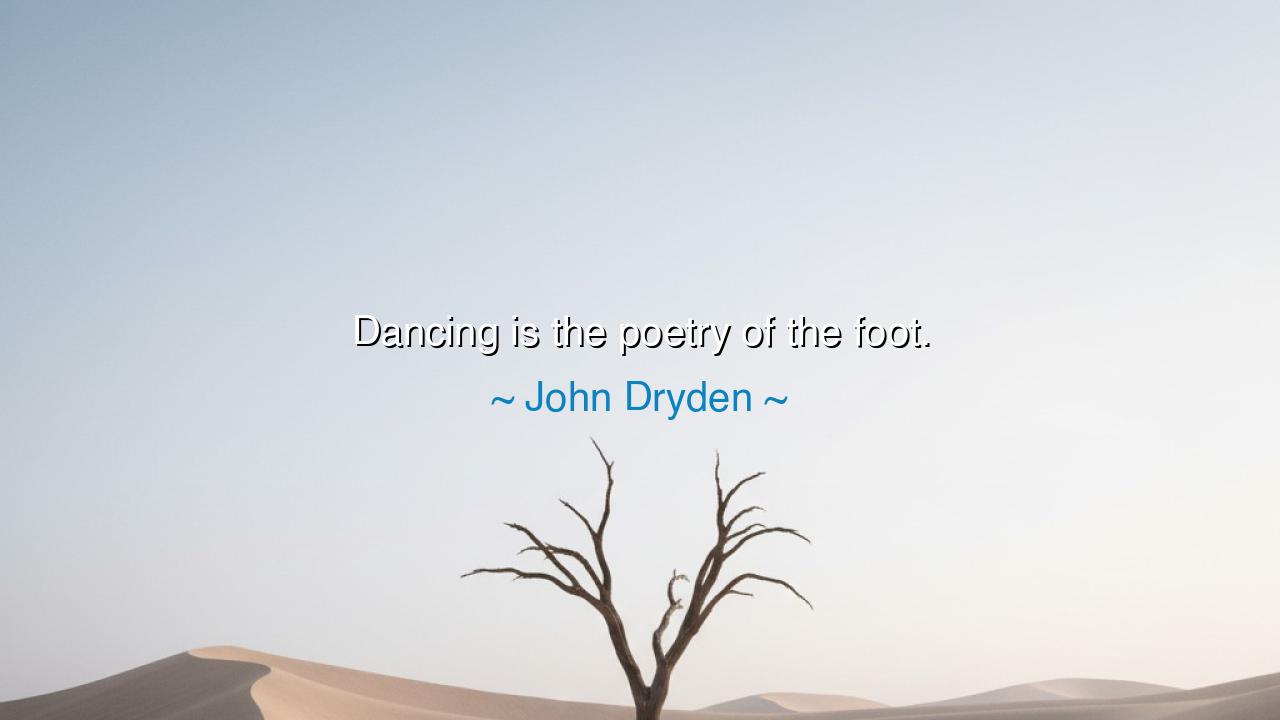
Dancing is the poetry of the foot.






Hear now the words of John Dryden, poet and sage of the seventeenth century, who proclaimed: “Dancing is the poetry of the foot.” This utterance is simple in form, yet profound in its depths. It declares that movement, when raised beyond mere necessity, becomes art; that the body, like the tongue, can write verses; and that rhythm, whether spoken or stepped, is the common language of the soul. For just as words can be woven into poetry, so too can footsteps be shaped into beauty, carrying meaning without the need for speech.
The foot, humble and earthly, is here elevated to the realm of art. Dryden reminds us that poetry does not live only in books or in lofty declamations. It can also be carved in space, painted upon the air, written in the movements of the body. Dancing is this hidden poetry: a hymn to rhythm, a dialogue between flesh and music, a verse inscribed in the language of motion. To watch a dancer is to read a poem without letters, to feel with the heart what cannot be said with the tongue.
History gives us shining examples of this truth. In ancient Greece, dance was inseparable from worship and drama. The chorus, moving in harmony, embodied the rhythm of the cosmos itself. In India, the classical Bharatanatyam dance told stories of gods and mortals not with ink, but with gesture, posture, and footwork. The poetry of the foot carried myth across generations, reminding the people of who they were and what they believed. So too in Africa, where drum and dance united the tribe, carrying history in the pulse of movement. Thus, Dryden’s phrase, though English in origin, speaks a universal truth.
Consider also the story of Isadora Duncan, who broke free from rigid forms of ballet in the modern age. She danced barefoot, letting her steps follow the rhythm of wind, sea, and soul. Critics scorned her at first, but she was unshaken. “I am the poet of my body,” she seemed to declare, “and my steps are verses.” Duncan’s revolution showed once again that the poetry of the foot is not bound to tradition alone; it is the eternal ability of movement to speak where words fall silent.
Dryden’s wisdom carries a deeper meaning still: that art is not confined to one sense or one form. Poetry is not only in ink—it is in every act of expression that reaches beyond the ordinary. For when the body moves with grace and purpose, it too becomes a vessel of imagination. To call dancing “poetry” is to remind us that beauty is everywhere, and that human beings are capable of turning even walking, even stepping, into a hymn of harmony.
The lesson for us is clear. Do not think of art as something distant, reserved only for poets and painters. You, too, may live poetically, if you give rhythm and intention to your actions. Walk with presence. Dance when the spirit moves you. Let your body be an instrument, not merely of survival, but of joy. To live with such awareness is to make your whole existence a poem.
Therefore, remember Dryden’s truth: Dancing is the poetry of the foot. Where music plays, let your body answer. Where silence reigns, let your steps still carry meaning. Make poetry not only with your words, but with your gestures, your daily movements, your very way of living. For when life itself becomes dance, you will find that you have written verses upon the earth with every step you take.






The idea that dance is the 'poetry of the foot' is so beautiful and true. It suggests that the body itself has a poetic language, speaking through movement rather than words. But how do we interpret this poetry? Is the emotional expression in dance always understood in the same way, or is it subjective, depending on the viewer? Can dance communicate meaning as effectively as poetry, or do we need the context of words to fully understand its message?
VCViet Ca
Dryden's metaphor of dance as 'the poetry of the foot' is thought-provoking because it makes me wonder about the deeper meaning behind physical expression. Does this mean that every movement in dance can be seen as a form of written expression, much like verses in a poem? How can we interpret the language of dance and what does it reveal about the human experience? Can dance truly replace words as a form of storytelling?
1L14-My Linh
I love how Dryden equates dance with poetry, showing that art doesn't have to be limited to traditional forms. It makes me think about how dance, just like poetry, can tell stories and convey emotions in such an elegant and personal way. Is it possible that dance is a universal language, capable of expressing things that words sometimes fail to capture? How does the rhythm and flow of movement translate into meaning?
GH10CV1-04- Do Thy Gia Han
John Dryden's quote about dancing being the 'poetry of the foot' really resonates with me, as it highlights the connection between movement and expression. Dance is often described as an art form that transcends words, yet here Dryden suggests that it is just as much a form of poetry. How much does the physicality of dance allow for a deeper emotional expression than words alone? Can movement communicate complex emotions in ways that spoken language cannot?